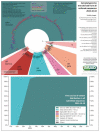The emergence of SARS-CoV-2 Omicron subvariants: current situation and future trends
- PMID: 36482957
- PMCID: PMC9714996
- DOI: 10.53854/liim-3004-2
The emergence of SARS-CoV-2 Omicron subvariants: current situation and future trends
Abstract
The SARS-CoV-2 Omicron variant (B.1.1.529) has been the most recent variant of concern (VOC) established by the World Health Organization (WHO). Because of its greater infectivity and immune evasion, this variant quickly became the dominant type of circulating SARS-CoV-2 worldwide. Our literature review thoroughly explains the current state of Omicron emergence, particularly by comparing different omicron subvariants, including BA.2, BA.1, and BA.3. Such elaboration would be based on structural variations, mutations, clinical manifestation, transmissibility, pathogenicity, and vaccination effectiveness. The most notable difference between the three subvariants is the insufficiency of deletion (Δ69-70) in the spike protein, which results in a lower detection rate of the spike (S) gene target known as (S) gene target failure (SGTF). Furthermore, BA.2 had a stronger affinity to the human Angiotensin-converting Enzyme (hACE2) receptor than other Omicron sub-lineages. Regarding the number of mutations, BA.1.1 has the most (40), followed by BA.1, BA.3, and BA.3 with 39, 34, and 31 mutations, respectively. In addition, BA.2 and BA.3 have greater transmissibility than other sub-lineages (BA.1 and BA.1.1). These characteristics are primarily responsible for Omicron's vast geographical spread and high contagiousness rates, particularly BA.2 sub-lineages.
Keywords: BA.2 sub-lineages; COVID-19; Omicron variant; SARS-CoV-2; immune evasion; spike protein; transmissibility.
Conflict of interest statement
Declaration of competing interest Authors have no conflict of interest, except AJ Rodriguez-Morales, speaker/consultant for Amgen, AstraZeneca, and Valneva, concerning COVID-19 vaccines.
Figures




References
-
- COVID Live-Coronavirus Statistics-Worldometer. [accessed 22 Oct2022]. https://www.worldometers.info/coronavirus/
-
- Kannan S, Shaik Syed Ali P, Sheeza A. Evolving biothreat of variant SARS-CoV-2 - molecular properties, virulence and epidemiology. Eur Rev Med Pharmacol Sci. 2021;25:4405–4412. - PubMed
-
- Kannan S, Shaik Syed Ali P, Sheeza A. Omicron (B.1.1.529) - variant of concern - molecular profile and epidemiology: a mini review. Eur Rev Med Pharmacol Sci. 2021;25:8019–8022. - PubMed
Publication types
LinkOut - more resources
Full Text Sources
Miscellaneous
